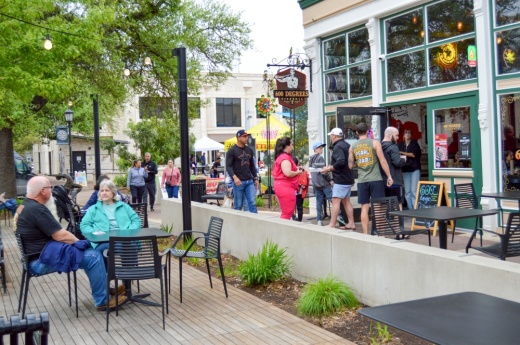Once dubbed the “Urban Frontiersman” by local newspapers, Nelson Nagle began his real estate journey in 1998, renovating his first run-down house on the south side of Main Street and repurposing it for his private counseling practice.
Nelson’s effort to revamp properties from old homes to businesses on the south side laid the groundwork for the future aesthetic of downtown—a blend of residential, commercial, retail and public amenities.
Building off his work, the city of Round Rock has invested nearly $200 million in public infrastructure and facilities since 2010.
Two-minute impact
Early signs of revitalization in downtown are visible in Nagle’s work. Today, several projects are underway to further expand the downtown footprint and bring new opportunities for growth and redevelopment.
“To be authentic doesn’t mean that you’re just going to be one thing forever,” Assistant City Manager Brooks Bennett said. “And as the community changes, we want the downtown to be a reflection of the past, as well as where we are today.”
The city has and continues to contribute to the effort initiated by Nagle and others—nearly 30 years ago—in creating a bustling downtown.
In January, the city relocated the historic Palm House—built in 1873—from downtown back to its original location off Hwy. 79, making way for a paseo, or walkway, connecting the Round Rock Public Library to Main Street.
Within the scope of the same project, the Griffith Building—formerly home to the library—is undergoing renovations to house the Round Rock Chamber headquarters, a visitors center and a city art gallery.
Both Heritage Trail West and Lake Creek Trail are expected to be complete by the end of this summer, providing connections under I-35 from west Round Rock into the downtown area.
Recent voter-approved bond funding in 2023 also set into motion several additional projects for green spaces in the downtown area.
Meanwhile, rezoning initiatives over the years have furthered the city’s goal of establishing at least 1,000 residential units within a quarter-mile radius of Main Street, Assistant City Manager Brad Wiseman said.
How we got here
What started as a business venture later became a hobby. Nagle first renovated a house at 400 W. Main St. into a commercial property for his private counseling practice. He soon found himself faced with many of the surrounding homeowners asking him to buy and repurpose their properties.
Nagle recalled times when neighbors would interrupt a meeting with a client, knocking on the door to ask, “Will you buy my house?”
The real estate entrepreneur said he took an area, known as the Southwest Downtown Historic District, and brought the old to meet the new. Similar to the way Rainey Street in Austin used to look, Nagle imagined an area that gave clients and visitors a comfortable and intimate feeling.
Nagle took advantage of an incentive from the city to improve the old neighborhood. He explained that preserving the history of the area remained important throughout his efforts.
“When I sit here on this corner, I can feel the history,” Nagle said while sitting in Urban Eat.Drink, a restaurant still owned by his family today. “This is really a prototype of what can be built upon and expanded [in Downtown Round Rock].”
While he no longer pursues residential-to-
commercial renovations, Nagle champions others interested in revitalization efforts in the downtown area.
Nagle’s work predates the establishment of many of the newer businesses on Main Street during the 2010s, which are familiar today. Several current business owners and city staff members attended high school with Nagle’s children, reminiscing about the work he undertook long before their involvement in the present downtown operations.
Quote of note
“The city had the vision—they put the incentive out there. I’m the one that accepted the challenge,” said Nagle.
What’s happening
City Council’s approval of a $1.8 million contract with Design Workshop on Feb. 8—for the planning and design of a new 20-acre park and trail along Brushy Creek—adds to nearly 15 years of elected officials’ support for downtown revitalization.
An initial Downtown Master Plan was adopted in 2010 and has since been updated through policies outlined in the 2030 Comprehensive Plan.
The project, known as the Lawn at Brushy Creek, will expand the perceived boundaries of downtown toward Hwy. 79, according to city officials. The contract also outlines plans to renovate the green area around the downtown water tower.
In contrast, the paseo—described by city staff as an urban park—will bridge Main Street to the streets beyond. Free Wi-Fi will be available, extending the library’s public workspace to the outdoors.
Some of the projects the city of Round Rock is funding include:
- Library and parking garage: $48.1 million
- Lake Creek Trail and Heritage Trail West: $21.96 million
- Griffith Building and paseo: $19.5 million
- Northeast downtown infrastructure improvements: $13 million
- Design costs of Lawn at Brushy Creek and Town Green: $1.81 million
Michelle Ly, a council member and the owner of several downtown businesses, said an increase of new residents will diversify downtown businesses
The city is working to attract more retail and daytime activity, said Jordan Robinson, president and CEO of the Round Rock Chamber. She explained that thriving communities often start with a vibrant downtown. She said the new chamber facilities in the Griffith Building will add to the diversity of businesses and visitors to the downtown area.
Though the Griffith Building will see a significant exterior facelift, great care was taken to preserve the historic feel along Main Street. City staff took physical brick samples along the street to ensure a cohesive design for the building.
Lauren Putrino Stroud, owner of Bliss Salon and Med Spa, welcomes the city’s plans to attract people beyond Main Street.
She said it’s a challenge to raise awareness about her business, despite its close proximity—just a block away on South Sheppard Street. Stroud is optimistic that the expansion efforts in downtown beyond Main Street will enhance visibility for local small businesses like hers.
Looking ahead
Future development and revitalization in downtown does face some challenges, Nagle said, adding that land is expensive.
He explained that in today’s real estate climate, he would not be able to do the same work he did 30 years ago.
Ly echoed the sentiment, saying restaurants and bars in downtown are struggling to pay high rent prices. She said she can’t imagine a retail company—who would see less business and be open fewer hours—able to operate in the downtown area.
City leaders remain hopeful, though, that the new trails, including the Lake Creek Trail and Heritage Trail West, will bring additional foot traffic to the downtown area and present new opportunities for business and growth on the north side of Main Street.
“It’s figuring out what downtown is going to look like 10 years from now or 50 years from now, and making sure that we have the infrastructure, the quality of life and amenities,” Bennett said.
Projects already finished or occurring over the next couple of years include:
- Round Rock Public Library: completed January 2023
- Library parking garage: completed January 2023
- The Depot townhomes: expected completion June 2024
- Lake Creek Trail: expected completion summer 2024
- Heritage West Trail: expected completion July 2024
- Monarch townhomes: expected completion early 2025
- Griffith Building and paseo: expected completion summer 2025





